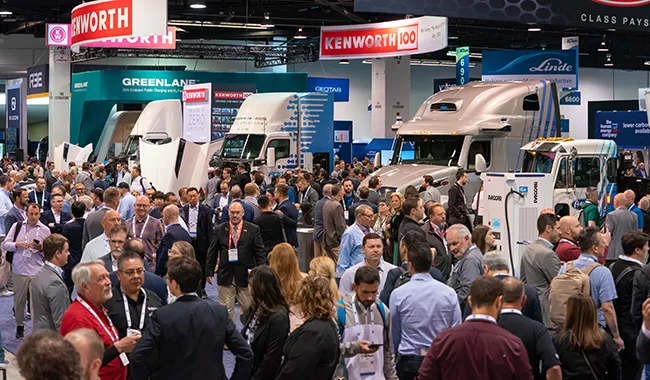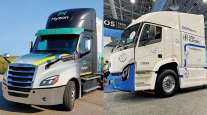Managing Editor, Features and Multimedia
Clean Truck Technologies Developing at Rapid Pace

[Stay on top of transportation news: Get TTNews in your inbox.]
ANAHEIM, Calif. — The rollout of zero-emission commercial vehicles and the infrastructure to support it is proceeding with added urgency as clean air regulators in California have set aggressive targets to phase out the diesel engines that have powered the trucking industry for generations.
Against that backdrop, manufacturers and suppliers showcased their latest efforts to propel the nascent zero-emission truck market at the 2023 Advanced Clean Transportation Expo, being held May 1-4 at the Anaheim Convention Center.
Truck makers continued to upgrade and expand their lineups of medium- and heavy-duty battery-electric trucks designed for applications such as shorthaul, drayage and local distribution.
The annual exhibition also featured a heavy focus on hydrogen fuel cell technology, which offers a pathway to extend the limited range of electric vehicles. Multiple truck makers displayed fuel cell electric Class 8 trucks on the show floor.
Other exhibitors highlighted renewable fuels for internal combustion engines, including hydrogen, renewable diesel and renewable natural gas.
“Despite diesel’s many benefits and despite its many efficiencies, we need a future comprised of alternatives — alternatives that offer us, our customers and society cleaner choices,” Daimler Truck North America CEO John O’Leary said in keynote remarks at the show. “Whether battery-electric, hydrogen fuel cell or hydrogen combustion, alternatives do exist.”
During the past year, government and private sector investments have put more and more zero- and low-emission commercial vehicles on the road, said Erik Neandross, CEO of clean technology consulting firm Gladstein, Neandross & Associates, which organizes ACT Expo.

Erik Neandross, CEO of ACT Expo organizer Gladstein, Neandross & Associates, highlights recent investments in zero-emission commercial vehicles. (Seth Clevenger/Transport Topics)
“There are billions and billions of dollars being pushed into this market from every angle,” he said.
Regulation also continues to drive the transportation industry toward cleaner technologies.
ACT Expo kicked off just a few days after California’s Air Resources Board voted to finalize its Advanced Clean Fleets rule, which bans the sale of new diesel-powered commercial vehicles in the state by 2036 and requires trucking companies operating there to transition their fleets toward zero-emission vehicles in the years and decades ahead.
CARB’s zero-emission vehicle mandate has drawn sharp criticism from the trucking industry, with American Trucking Associations making the case that zero-emission trucks remain early-stage technologies that still lack the necessary infrastructure to support them.

Paccar's John Rich says the move toward zero-emission trucking will require both innovation and collaboration. (Todd Wawrychuk)
John Rich, chief technology officer at truck maker Paccar Inc., said achieving zero emissions will be a great challenge, but called on manufacturers, dealers, suppliers and fleets to work together to make this transition possible.
“Hitting these objectives without disrupting the transportation system will be incredibly difficult,” he said. “Nobody has enough money or skills to do this on their own. Just like previous generations, winners will innovate, collaborate and lead.”
The shift in public policy and funding toward zero-emission commercial vehicles may signal an earlier-than-expected sunset for further development of the diesel engine, according to GNA’s 2023 State of Sustainable Fleets market brief.
That annual report, unveiled during ACT Expo, cited zero-emission vehicle mandates that have been approved or are under consideration in 13 states, along with the availability of public funding incentives for clean vehicles and infrastructure.
At the same time, the U.S. Environmental Protection Agency and CARB have set stricter limits on nitrogen-oxide emissions for future diesel-powered trucks that likely will drive up the cost and complexity of those vehicles. Manufacturers also will need to meet increasingly stringent greenhouse gas emission standards.
I’m seeing lots of hydrogen fuel cell trucks here at #ACTexpo, including this @KenworthTruckCo T680 equipped with @Toyota fuel cell technology. pic.twitter.com/zZGKUiJAsV — Seth Clevenger (@SethClevenger) May 2, 2023
To produce diesel engines with super-low emission levels will be both difficult and expensive, GNA’s Neandross said, adding that price tag on these rules could easily raise the cost of a new diesel tractor by $30,000 while also increasing maintenance expenses.
“We’re starting to hear folks talk about the sunset of the diesel era, and we believe that 2027 could very well be the last of the major diesel development programs that we see out there in the world,” he said. “Diesel will continue to go on, but as far as continued investment, that may be it.”
Although regulations and incentives are accelerating the push toward zero-emission trucking, GNA’s report also highlighted barriers to adoption, including multiyear delays for the electrical service capacity that have slowed down some fleets’ electric truck deployment plans.
Reaching cost parity with diesel also remains a key hurdle for zero-emission technologies.
“Trucks are not vanity purchases. They are tools. And with any tool, operating cost is king,” Paccar’s Rich said. “Right now, making progress with air quality and CO2 is expensive. This means that regulators will set the pace of transition to zero-emission vehicles, at least for the time being.”
DTNA’s O’Leary pointed to charging infrastructure as the weak link in the move toward zero-emission trucking, with lead times for depot charging projects often running longer than two years.

ACT Expo attendees explore zero- and low-emission commercial vehicle technologies on display at the Anaheim Convention Center. (Todd Wawrychuk)
“We cannot operate under the delusion that zero-emission technology for this industry is ready to completely supplant diesel today, or that it will be ready to do so next year or even five years from now,” he said. “We cannot deploy a nationwide charging network by the end of this decade one multiyear site build at a time.”
ACT Expo’s organizers expected the annual event to draw about 12,000 attendees this year.
Want more news? Listen to today's daily briefing below or go here for more info:




